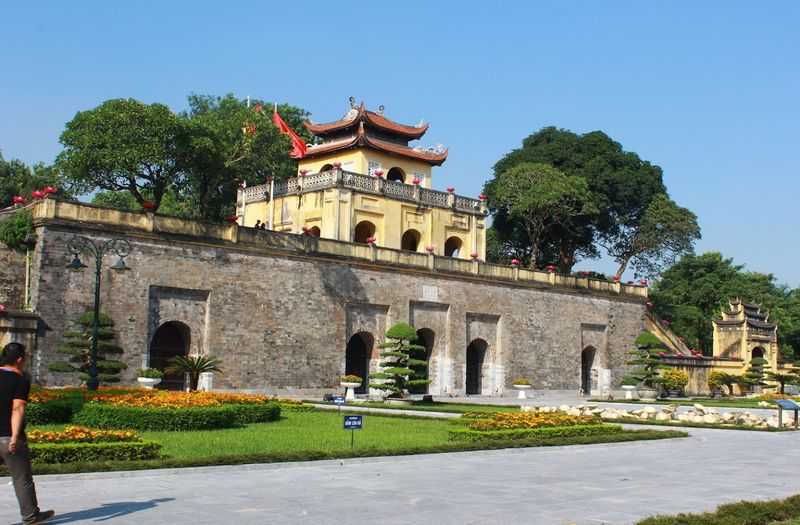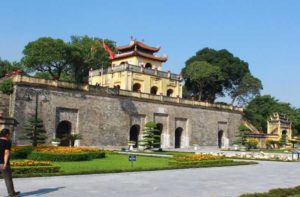Recently updated on September 10th, 2022 at 12:06 pm
Thang Long Imperial Citadel is a historical relic of the ancient Thang Long citadel, this is a huge architectural work, built by the dynasties in many historical periods and became the most important monument in the relics system of Vietnam.
Thang Long Imperial Citadel has been recognized by UNESCO as a world cultural heritage.
Thang Long Imperial Citadel relic area has a total area of 18,395 ha, including archaeological sites of 18 Hoang Dieu and other remnants in Hanoi ancient relics such as Doan Mon, Hanoi flagpole, Kinh Thien Palace, house D67, North Gate, Hau Lau, city walls…
Introduction to the relic The Imperial Citadel of Thang Long
The Imperial Citadel of Thang Long now belongs to Dien Bien and Quan Thanh wards, Ba Dinh district, Hanoi. The relic area has a total area of 18,395ha, including archaeological sites of 18 Hoang Dieu and other relics left in Hanoi’s ancient citadel such as Doan Mon, Hanoi flagpole, Kinh Thien palace, and D67 house. , Bac Mon, Hau Lau, city walls, and 8 gates of the royal palace under the Nguyen dynasty.
These monuments are located in the Ba Dinh district and are limited by routes: the North is Phan Dinh Phung Street, the South is Bac Son Street and the National Assembly Building, the Southwest is Dien Bien Phu Street, the West is Hoang Dieu Street, Doc Lap Street, National Assembly House and finally on the East is Nguyen Tri Phuong Street.
This is a place to visit definitely you will not be able to miss when traveling to Hanoi.
Where is Thang Long Imperial Citadel
Thang Long Imperial Citadel is located at 19C Hoang Dieu Street, Dien Bien Ward, Ba Dinh District, Hanoi.
How to get to Thang Long Imperial Citadel
To visit Thang Long Citadel, you go to 19C Hoang Dieu; This is the main gate for visitors. From the center of Hanoi, you can easily go to the Imperial Citadel by means of vehicles such as motorbikes, beautiful cars, cars, and buses …
If you take the bus you can take route 22, this bus will stop at the stop in front of Thang Long Imperial Citadel.
Places to visit in the relics of Thang Long Imperial Citadel
This Thang Long Imperial Citadel historic site includes many different places to visit, in the context of this article we will introduce you to places that attract a lot of domestic and foreign visitors.
The Flag Tower of Hanoi

The Hanoi flagpole is a relic built-in 1812 under the reign of King Gia Long. The flagpole is 60m high, the stand has a square shape with an area of 2007m².
Read more:
Kinh Thien Palace
Kinh Thien Palace is located in the center of the monument. Currently, the only remaining vestige of Kinh Thien Palace is the old foundation area, stone dragons, steps…
This is the central relic, the main nucleus in the overall historical vestiges of Hanoi’s ancient citadel. Kinh Thien Palace is located in the center of the relic.
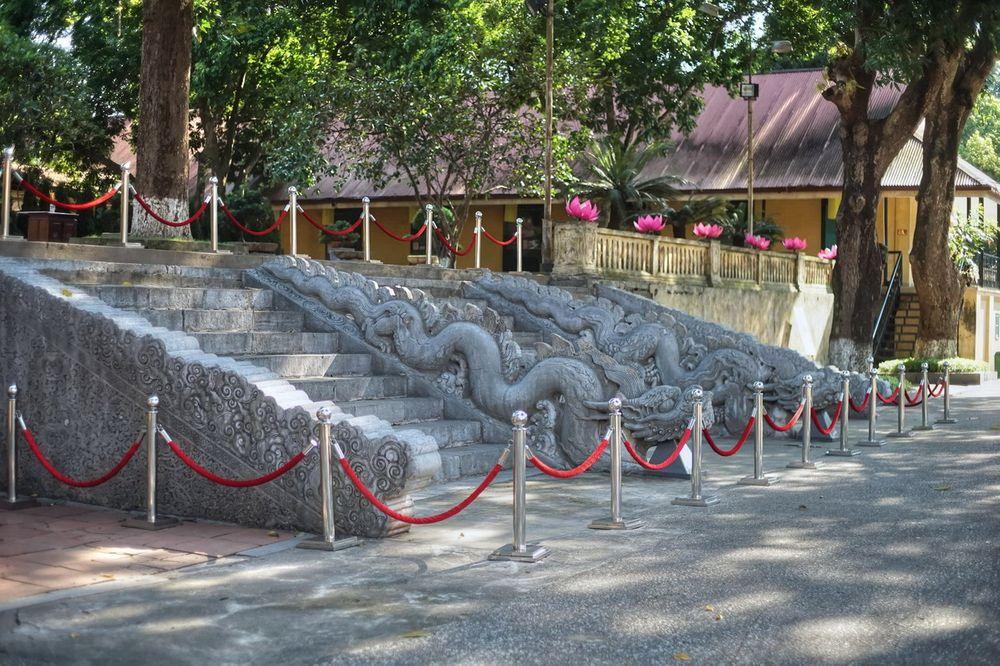
In front of Kinh Thien Palace is Doan Mon temple, then Hanoi flagpole, behind there are Hau Lau, Cua Bac, two east and west with walls and a small opening.
Currently, traces of Kinh Thien Palace remain only in the old foundation area. The south side of the powerhouse has a row of railings over one meter high. In the front, the main south direction of Kinh Thien Palace built a step system with large stone slabs.
Four stone dragons were created in the 15th century of the Le Dynasty. Kinh Thien electric stone dragon sculpture is a masterpiece of architectural artistic heritage, typical of sculpture art in the Le So period.
Two-step walls on either side of the electric platform were two stylized dragons.
Cua Bac (North Gate)

This is one of the five gates of Hanoi during the Nguyen Dynasty. In Cua Bac, there were still two artillery tracks from French boats fired from the Red River in 1882 when the French attacked Hanoi for a second time.
D67 House
This is where the Ministry of Defense and the Politburo have made historic decisions that mark the milestones of the Vietnamese revolution.
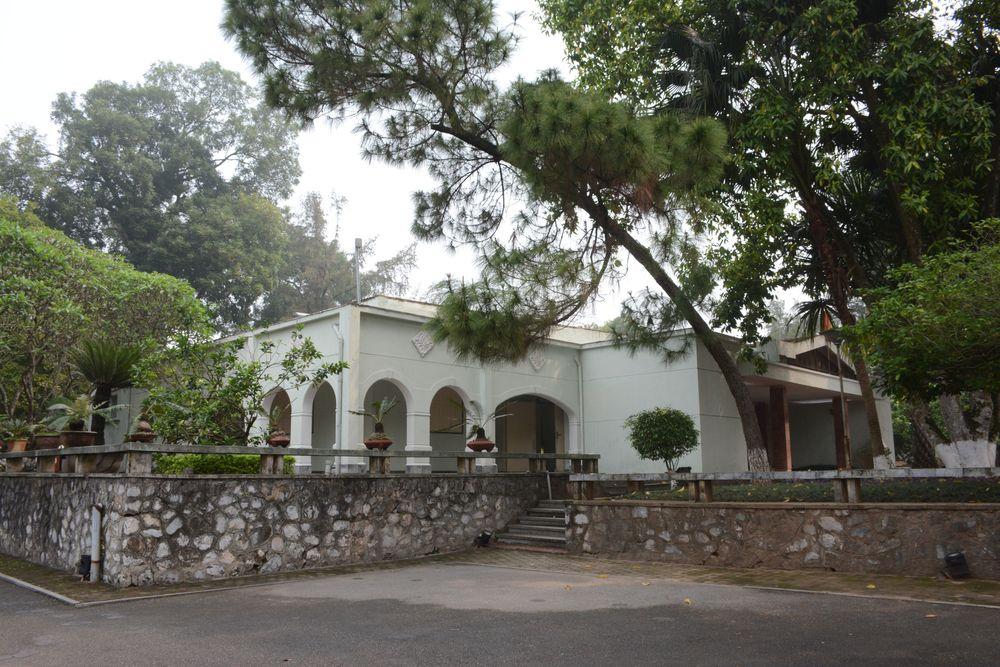
These were the Tet Offensive in 1968, and 1972 and the culmination of that was the Ho Chi Minh campaign in 1975 to liberate the South and reunite the country.
Archaeological Area 18 Hoang Dieu
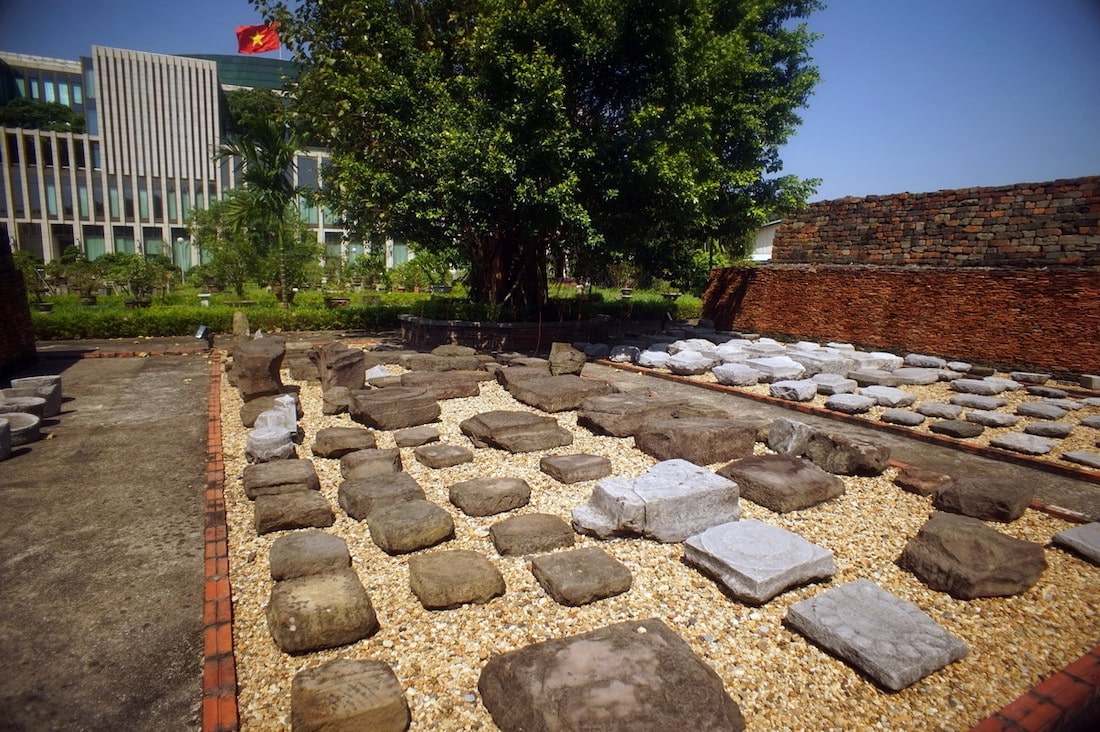
This relic includes the bottom floor which is an eastern part of Dai La citadel during the Cao Bien Dynasty of the Tang Dynasty; the upper floor is the palace of the Ly and Tran dynasties; followed by a central part of the eastern Le palace and, at the top, a part of the center of the 19th-century Hanoi citadel.
Hau Lau
Also known as Lau Tinh Bac (Tinh Bac Lau) is a story building behind Kinh Thien architectural cluster is the palace of the citadel.

Although being behind the palace but it is the north, built with the intention of feng-shui to keep the north of the palace. This is also the residence of the queen and princesses during the feudal period.
Night Tour “Decoding the Imperial Citadel of Thang Long”
The night tour “Decoding the Imperial Citadel of Thang Long” has really returned and received special attention from visitors. Coming to the night tour, visitors can imagine a part of the history of Thang Long Imperial Citadel stretching from the 7th to the 19th centuries, throughout the dynasties: Dai La, Ly, Tran, Mac Le, Nguyen. Let’s “decode” why the Imperial Citadel of Thang Long Night Tour attracts visitors.
A different and new feeling
Different from the usual tours, the night tour “Decoding the Imperial Citadel of Thang Long” is a special experience tour program.
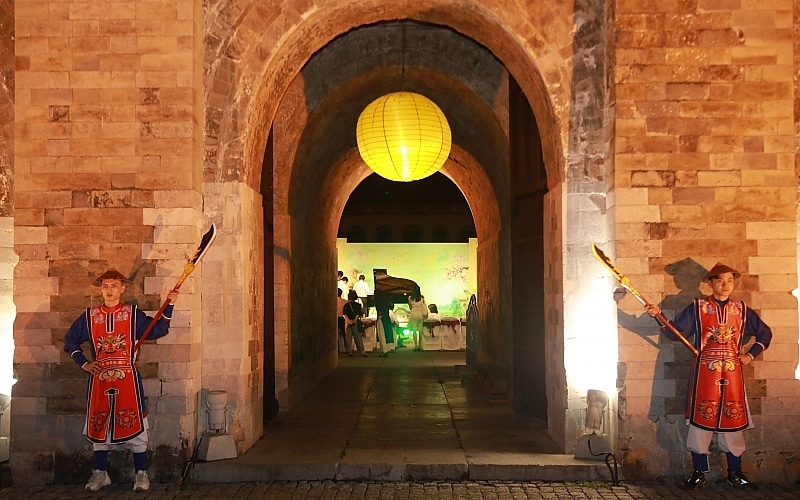
Night tour “Decoding the Imperial Citadel of Thang Long”
In the sacred space marked by the thousand-year history of the Imperial Citadel of Thang Long, academic music will give wings to the sacred soul of rivers and mountains in harmony with the echoes of the times, giving visitors a new and profound feeling. and proud.
Unique experience journey
The journey to experience the night tour “Decoding the Imperial Citadel of Thang Long” lasts about 1.5 hours, with a route starting from Doan Mon – the door leading to the Forbidden City, where the king lived and worked in the past; here visitors experience the space of the old Imperial Citadel, enjoy the royal dance right on the unique archaeological vestiges; continue to admire the precious artifacts and antiquities found at the Imperial Citadel of Thang Long in the display house with the theme “Thang Long Hanoi – A thousand-year history from the ground”; offering incense in memory of the ancestors at Kinh Thien Palace.
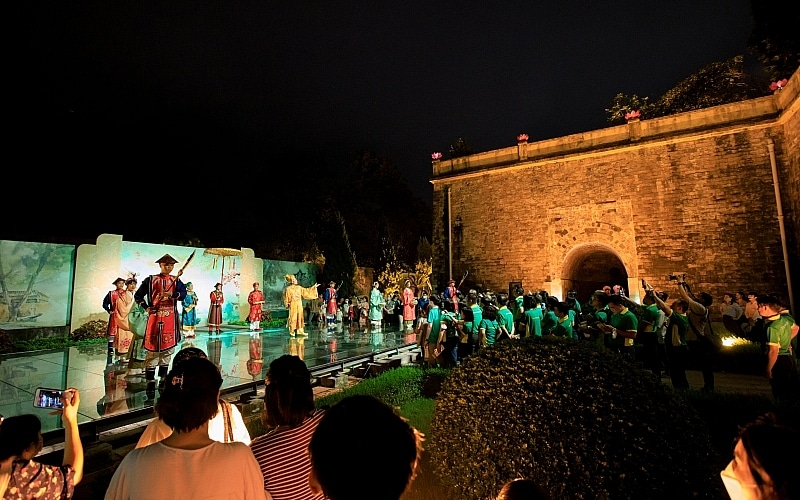
Enjoy the Royal Court Ceremony and the ancient dance “Thang Long Court”
The last attraction in the night tour itinerary is Archaeological Site 18 Hoang Dieu. Here, after many years of excavation, archaeologists have found millions of artifacts dating back to each other, stacked over 1300 years.
In the world, it is very rare that the capital of a country still preserves a complex of relics and relics with a long history and culture and has overlapping cultural layers, one after another. quite continuously like that.
This is a prominent feature, contributing to the great value and uniqueness of the relic.
Join the game Decoding the Imperial Citadel of Thang Long – receive souvenirs
At the end of the tour is the game Decoding the Imperial Citadel of Thang Long for all visitors. Accordingly, some typical artifacts of the Imperial Citadel will be shown by laser on the foundations of archaeological remains or on the ancient river for visitors to learn and answer. Interesting details and decoding hints will be revealed in turn during the tour.
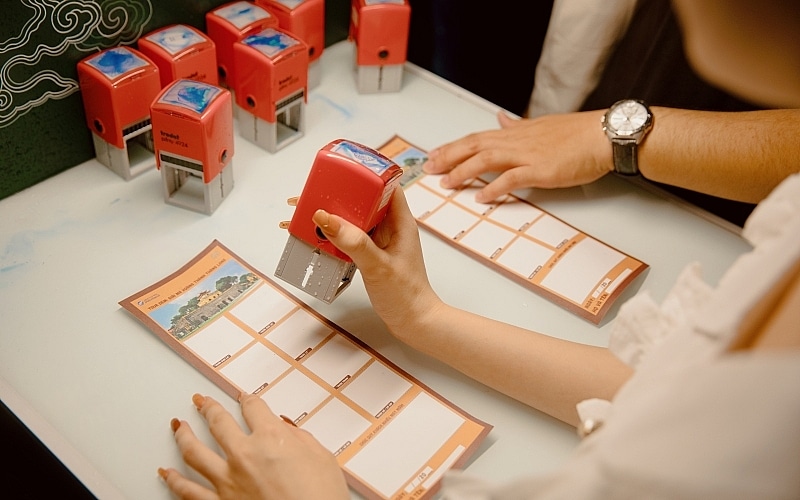
Game “Decoding the Imperial Citadel of Thang Long”
This is an interesting challenge, not only to help visitors have a relaxing time but also a way for visitors to review the information gained during the tour, challenging each person’s memory.
Correct decoding, visitors will receive meaningful souvenirs of the Imperial Citadel of Thang Long.
Special features only on a night tour
Attend the incense offering ceremony to commemorate the ancestors at Kinh Thien Palace, the center of heaven and earth, the center of the ancient Thang Long citadel.
Take your own cool water from the King’s well, the water source symbolizes abundant life and luck and blessings.
Enjoy lotus tea, and lotus jam right under the ancient Bodhi tree, a symbol of peace and luck.
Take “super cool” virtual live photos
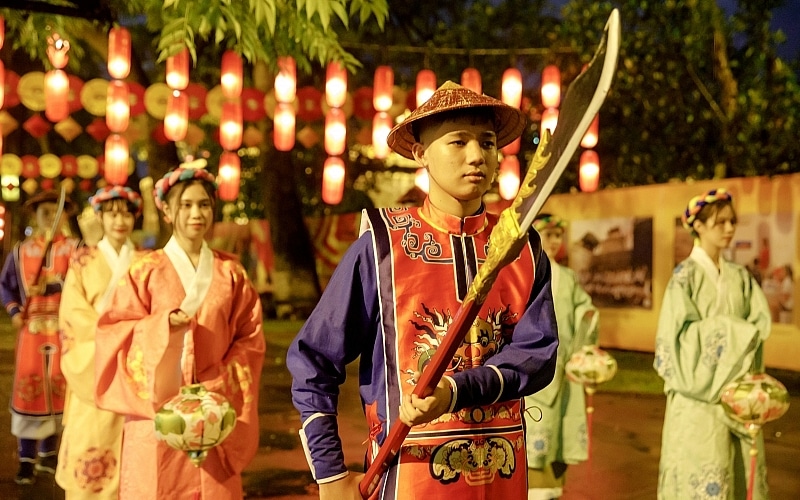
Take photos with the palace maidens and guards in ancient costumes
(Source: hoangthanhthanglong.com)
Notes
- Follow the tour guide map in the relic area.
- Do not bring weapons, explosives, flammables, toxic substances and substances with a fishy odor into the relic.
- Dress neatly and politely. Do not show unethical behaviors such as: swearing; write or draw on walls, tree stumps; causing disorder in the relic area. Vehicles and motorbikes must be left in the right place (at 19 C Hoang Dieu).
- Consciously protect relics and relics, maintain environmental hygiene, dispose of garbage in the right place. Do not arbitrarily climb trees, break branches, pick fruits, or step on grass.
- Units and groups that need a tour guide should contact the Interpretive Guide Department for service. Agencies and individuals wishing to film or edit movies must have a recommendation letter and get the consent of the leader of the Thang Long – Hanoi Heritage Conservation Center.
- Do not use ultralight aircraft (flycam) at the heritage site.

